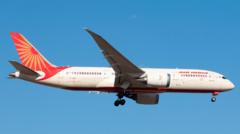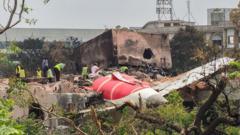Regulators in India and South Korea have initiated inspections of Boeing aircraft's fuel control switches, following alarming findings from the recent investigation into the Air India Flight 171 crash. Preliminary assessments highlighted that the fatal incident, which occurred after takeoff, was associated with the shut-off of both fuel control switches on the aircraft.
Boeing Fuel Switch Investigations Launched After Air India Crash

Boeing Fuel Switch Investigations Launched After Air India Crash
In the wake of a tragic Air India crash, regulators probe the safety of fuel control switches in Boeing aircraft across Asia.
Authorities in India and South Korea mandated the inspections this week as a follow-up to a detailed report emphasizing that the locking mechanisms intended to prevent accidental switch movements were not adequately evaluated or maintained by Air India. The report did not conclude the crash's causative factors nor assign blame, but continued efforts are focused on elucidating the role of human error in this aviation disaster.
Indian investigators pointed out that the two switches on the Boeing 787 were found in the "off" position mere seconds post-takeoff, casting doubt on mechanical failure or design shortcomings as factors. The report noted the recommended inspections mandated by the Federal Aviation Administration (FAA) in 2018 had not been performed due to their non-mandatory status. The FAA’s advisory highlighted concerns surrounding the switching mechanism but did not classify them as critical safety issues.
Following these findings, Singapore Airlines reported it had successfully completed inspections of similar fuel systems on its Boeing fleet, including its subsidiary Scoot. The cautionary measures reflect a growing global recognition of potential vulnerabilities in aviation safety.
As the investigation continues, the focus remains on resolving the complex issues surrounding the operational integrity of fuel control systems in Boeing aircraft, while the aviation community emphasizes the need for stringent adherence to safety recommendations.
Indian investigators pointed out that the two switches on the Boeing 787 were found in the "off" position mere seconds post-takeoff, casting doubt on mechanical failure or design shortcomings as factors. The report noted the recommended inspections mandated by the Federal Aviation Administration (FAA) in 2018 had not been performed due to their non-mandatory status. The FAA’s advisory highlighted concerns surrounding the switching mechanism but did not classify them as critical safety issues.
Following these findings, Singapore Airlines reported it had successfully completed inspections of similar fuel systems on its Boeing fleet, including its subsidiary Scoot. The cautionary measures reflect a growing global recognition of potential vulnerabilities in aviation safety.
As the investigation continues, the focus remains on resolving the complex issues surrounding the operational integrity of fuel control systems in Boeing aircraft, while the aviation community emphasizes the need for stringent adherence to safety recommendations.






















